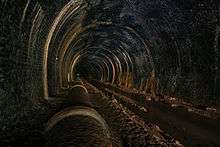Wenvoe Tunnel
_(4860074229)_(2).jpg) North portal | |
| Overview | |
|---|---|
| Line | Barry Railway |
| Location | Culverhouse Cross, Vale of Glamorgan, Wales |
| Coordinates |
S 51°27′28″N 3°15′39″W / 51.457821°N 3.260892°W N 51°28′09″N 3°16′35″W / 51.469250°N 3.276423°W |
| Status | Closed |
| Operation | |
| Opened | 1889 |
| Closed | 1963 |
| Technical | |
| Length | 1,867 yards (1,707 m) |
Wenvoe Tunnel is a disused tunnel on the defunct Barry Railway that runs under Culverhouse Cross on the western outskirts of Cardiff, in the Vale of Glamorgan, south Wales. It was opened in 1889 on a line used to carry coal to Barry Docks, and closed in 1963.
Description
The southern end of the tunnel is to the west of The Alps Quarry, off Caerau Lane, and the northern end is north of Culverhouse Cross Retail Park, just west of the A4232 road and south east of the hamlet of Drope.[1] The tunnel carried the Barry Railway for 1867 yards through the downs before it crossed the River Ely on the Drope viaduct of 178 yards and St.Fagans viaduct of 180 yards over the South Wales main line and continued north to the coal fields[2]but at just under half-mile north of its northern portal, a single line branch to Peterston-super-Ely ran to the west. Further still, at 1·35 miles from the northern portal, Tynycaeau Junction was the location of the divergence of the Cadoxton-Pontypridd line with the Penrhos Branch which ran to Caerphilly and the Rhymney valley. The tunnel passed under the A48 Cardiff—Cowbridge road. The other main works on the railway were the Pontypridd (or Graig) tunnel 0.75 miles (1.21 km) at Treforest and a viaduct over the River Ely 534 feet (163 m) long and 62 feet (19 m) high.[3] plus the St. Fagans viaduct mentioned above.
A British Rail Gazetteer says the tunnel, between Wenvoe and Drope Junction, is just over 1 mile (1.6 km) long, at 1,867 yards (1,707 m).[4] More simply, the closed tunnel on the former Barry–Pontypridd route is 1,867 yards (1,707 m) long, the 9th longest Great Western tunnel.[5] It is brick-lined apart from a short section at the south end. There is one brick-lined ventilation shaft at the centre, almost as wide as the tunnel. Its original air shaft chimney of circular red brick with staffordshire blue corbelling was removed following closure and a breeze-block structure built to the rear of a concrete-aproned area of a retail outlet and which at ground level, occupies an air way of only a quadrant of the circular air shaft below ground[6]
Construction

The Barry Docks and Barry Railway Company were founded to break the effective monopoly that the Taff Vale Railway and the Cardiff Docks had established over export of coal from the South Wales Coalfield. Work on the railway began in 1885, and within four years included an 18.5 miles (29.8 km) line from Trehafod to the Barry Docks, with several branch lines.[6]
In July 1885 The Engineer reported that the heavy work at Wenvoe Tunnel was being pressed forward, and it was expected that there would soon be 3,000 men at work on the project.[7] The earth was removed from the tunnel using skips that held 1 cubic yard (0.76 m3) and ran on three 1.75 feet (0.53 m) roads, mostly pulled by ponies.[8] The skips were run out to the tip, where they could be lifted by hand when off the road.[9] Several pressurized oil lights were used to allow night work. In the deep cutting to the north they were connected to a pump that was used to clear water from the tunnel. In the rock cutting to the south they were connected to air compressors used to drive rock drills.[10]
History
The double-track tunnel was opened for service in 1889. It was closed on 31 March 1963 after the Tynycaeau North signal box was destroyed by fire.[6] The stone above the north portal with the date of 1888 is now covered in moss and scarcely legible.[11] The top of the ventilation shaft is enclosed in a concrete building in a retail parking lot in Culverhouse Cross.[12] The tunnel contains a large water main. It is subject to flooding up to 4 feet (1.2 m) in depth after heavy rainfall.[6]
Notes
- ↑ England and Wales OS Six Inch.
- ↑ Mortimer 2014, PT296.
- ↑ Bell 1886, p. 58.
- ↑ Gazetteer: Tunnels – British Railways.
- ↑ Nicholson.
- 1 2 3 4 Wenvoe Tunnel – Forgotten Relics.
- ↑ Our correspondent 1885, p. 96.
- ↑ Institution of Civil Engineers 1894, p. 174.
- ↑ Institution of Civil Engineers 1894, p. 175.
- ↑ Robinson 1887, p. 93.
- ↑ Wenvoe tunnel – Fluidr.
- ↑ Lygad 2016.
| Wikimedia Commons has media related to Wenvoe tunnel. |
Sources
- Bell, James (1886), "Barry Dock and Railways", Reports and Transactions - Cardiff Naturalists ́Society, retrieved 2016-04-09
- England and Wales OS Six Inch, 1888-1913 National Library of Scotland, retrieved 2016-04-09
- Gazetteer: Tunnels, British Railways, retrieved 2016-04-09
- Institution of Civil Engineers (1894), Minutes of Proceedings of the Institution of Civil Engineers, The Institution, retrieved 2016-04-09
- Lygad, Dai (11 January 2016), "Underground history: Wenvoe Tunnel ventilation shaft, Culverhouse Cross, Cardiff", Djibouti web portal, retrieved 2016-04-09
- Mortimer, Dic (2014-10-08), Cardiff: The Biography, Amberley Publishing Limited, ISBN 978-1-4456-4251-2, retrieved 2016-04-09
- Nicholson, Nigel, Great Western Tunnels, retrieved 2016-04-09
- Our correspondent (1885), "Wales and Adjoining Counties", The Engineer, retrieved 2016-04-09
- Robinson, John (6 December 1887), "Illumination from Waste Oils", Journal of the Royal Society of Arts ..., G. Bell and Sons, retrieved 2016-04-09
- "Wenvoe tunnel", Fluidr, retrieved 2016-04-09
- "Wenvoe Tunnel", Forgotten Relics, retrieved 2016-04-09